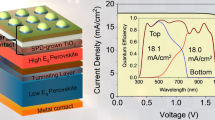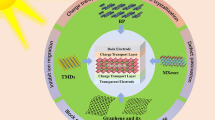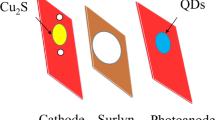Abstract
In-situ prepared MoO3 thin layer has been introduced to suppress the formation of too thick Mo(S,Se)2 layer in Cu2ZnSnSxSe4-x (CZTSSe) solar cells. This MoO3 layer effectively improves the back interfacial contact between CZTSSe absorber layer and Mo substrate without poisoning the carrier transport. Up to 10.58% power conversion efficiency has been achieved.
Abstract
在空气中对钼基底进行退火处理, 在钼表面形成MoO3薄层. 该MoO3薄膜能有效抑制过厚Mo(S,Se)2的形成. 研究发现, MoO3厚度随着温度的升高而增大, 其中350°C形成的MoO3厚度最为合适, 既能够有效降低Mo(S,Se)2的厚度, 又不影响吸收层和钼电极接触, 器件最高效率达到10.58%. 这种方法不会引入其他杂质元素, 操作简单方便.
Similar content being viewed by others
References
Zhou H, Hsu WC, Duan HS, et al. CZTS nanocrystals: a promising approach for next generation thin film photovoltaics. Energy Environ Sci, 2013, 6: 2822–2838
Polizzotti A, Repins IL, Noufi R, et al. The state and future prospects of kesterite photovoltaics. Energy Environ Sci, 2013, 6: 3171–3182
Chen S, Walsh A, Gong XG, et al. Classification of lattice defects in the kesterite Cu2ZnSnS4 and Cu2ZnSnSe4 earth-abundant solar cell absorbers. Adv Mater, 2013, 25: 1522–1539
Kumar M, Dubey A, Adhikari N, et al. Strategic review of secondary phases, defects and defect-complexes in kesterite CZTS–Se solar cells. Energy Environ Sci, 2015, 8: 3134–3159
Li J, Wang D, Li X, et al. Cation substitution in earth-abundant kesterite photovoltaic materials. Adv Sci, 2018, 5: 1700744
Yan C, Huang J, Sun K, et al. Cu2ZnSnS4 solar cells with over 10% power conversion efficiency enabled by heterojunction heat treatment. Nat Energy, 2018, 3: 764–772
Shin B, Bojarczuk NA, Guha S. On the kinetics of MoSe2 interfacial layer formation in chalcogen-based thin film solar cells with a molybdenum back contact. Appl Phys Lett, 2013, 102: 091907
Yang KJ, Sim JH, Jeon B, et al. Effects of Na and MoS2 on Cu2ZnSnS4 thin-film solar cell. Prog Photovolt-Res Appl, 2015, 23: 862–873
Scragg JJ, Wätjen JT, Edoff M, et al. A detrimental reaction at the molybdenum back contact in Cu2ZnSn(S,Se)4 thin-film solar cells. J Am Chem Soc, 2012, 134: 19330–19333
Li J, Zhang Y, Zhao W, et al. A temporary barrier effect of the alloy layer during selenization: tailoring the thickness of MoSe2 for efficient Cu2ZnSnSe4 solar cells. Adv Energy Mater, 2015, 5: 1402178
Shin B, Zhu Y, Bojarczuk NA, et al. Control of an interfacial MoSe2 layer in Cu2ZnSnSe4 thin film solar cells: 8.9% power conversion efficiency with a TiN diffusion barrier. Appl Phys Lett, 2012, 101: 053903
Liu F, Sun K, Li W, et al. Enhancing the Cu2ZnSnS4 solar cell efficiency by back contact modification: Inserting a thin TiB2 intermediate layer at Cu2ZnSnS4/Mo interface. Appl Phys Lett, 2014, 104: 051105
Li W, Han X, Zhao Y, et al. Pre-annealing induced oxide barrier to suppress the over-selenization of Mo contact. J Mater Sci-Mater Electron, 2016, 27: 11188–11191
Chernova NA, Roppolo M, Dillon AC, et al. Layered vanadium and molybdenum oxides: batteries and electrochromics. J Mater Chem, 2009, 19: 2526–2552
Ding QP, Huang HB, Duan JH, et al. Molybdenum trioxide nanostructures prepared by thermal oxidization of molybdenum. J Cryst Growth, 2006, 294: 304–308
Kröger M, Hamwi S, Meyer J, et al. P-type do** of organic wide band gap materials by transition metal oxides: a case-study on molybdenum trioxide. Org Electron, 2009, 10: 932–938
Tian Q, Wang G, Zhao W, et al. Versatile and low-toxic solution approach to binary, ternary, and quaternary metal sulfide thin films and its application in Cu2ZnSn(S,Se)4 solar cells. Chem Mater, 2014, 26: 3098–3103
Min X, Shi J, Guo L, et al. Regulation of Zn/Sn ratio in kesterite absorbers to boost 10% efficiency of Cu2ZnSn(S,Se)4 solar cells. Chin Phys B, 2018, 27: 016402
Haass SG, Diethelm M, Werner M, et al. 11.2% Efficient solution processed kesterite solar cell with a low voltage deficit. Adv Energy Mater, 2015, 5: 1500712
Shin D, Saparov B, Mitzi DB. Defect engineering in multinary earth-abundant chalcogenide photovoltaic materials. Adv Energy Mater, 2017, 7: 1602366
Acknowledgements
This work was financially supported by the National Natural Science Foundation of China (91733301, 51761145042, 51627803, 21501183, 51402348, 11474333, 91433205 and 51421002), the Knowledge Innovation Program and the Strategic Priority Research Program (Grant XDB 12010400) of the Chinese Academy of Sciences.
Author information
Authors and Affiliations
Corresponding authors
Additional information
Xue Min received her bachelor degree in the School of Optical and Electronic Information, Huazhong University of Science and Technology in 2015, and received her master degree in Institute of Physics (IOP), Chinese Academy of Sciences (CAS) in 2018. Her work mainly focused on develo** highly efficient Cu2ZnSnSxSe4-x solar cells and related materials.
Dongmei Li is a full professor at IOP, CAS. She received her PhD from Jilin University in 1999. In 2000, she was a postdoctoral fellow in Nihon University. From 2001 to 2003, she was a research associate in Cardiff University, UK. From 2003 to 2005, she worked in the College of Chemistry, Jilin University. Since 2005, she has been working in IOP. Her current research interest focuses on solar energy materials & devices, including new generation solar cells and photocatalytic materials. She has published over 170 papers, which were cited over 7,700 times (h-index 44), applied over 50 patents in which over 30 patents were authorized.
Qingbo Meng is currently a full professor at IOP, CAS, director of Center for Clean Energy, IOP. He received his PhD degree in 1997 from Changchun Institute of Applied Chemistry, CAS. From 1997 to 1999, he was a postdoctoral fellow in IOP. From 1999 to 2002, he was a STA Fellow (Science and Technology Agency of Japan) and Researcher of the University of Tokyo and KAST in Japan. He was selected as “Distinguished Young Scholars” from NSFC in 2007 and the project leader of the Fund for Creative Research Groups of China in 2014. He was awarded to “the Special Allowance of the State Council” in 2010 and “The president of the Tokyo University Science Award” in 2011. His current research interest focuses on solar energy materials & devices, including new generation thin film solar cells (such as perovskite solar cells, kesterite solar cells, quantum dot solar cells) and photocatalytic materials. He has published over 220 papers, which were cited over 8,600 times (h-index 55). He has applied over 80 patents, and over 50 patents were authorized.
Rights and permissions
About this article
Cite this article
Min, X., Guo, L., Yu, Q. et al. Enhancing back interfacial contact by in-situ prepared MoO3 thin layer for Cu2ZnSnSxSe4-x solar cells. Sci. China Mater. 62, 797–802 (2019). https://doi.org/10.1007/s40843-018-9381-1
Received:
Accepted:
Published:
Issue Date:
DOI: https://doi.org/10.1007/s40843-018-9381-1




